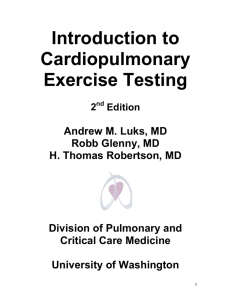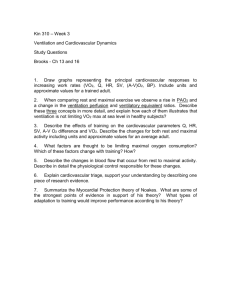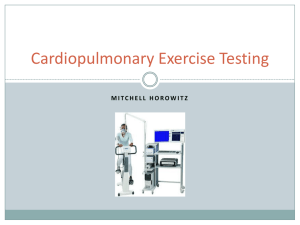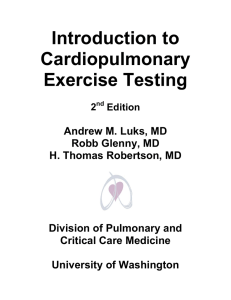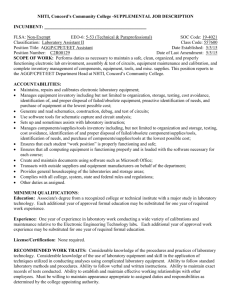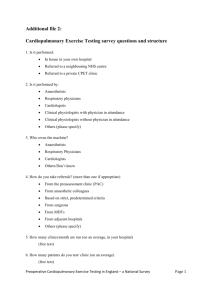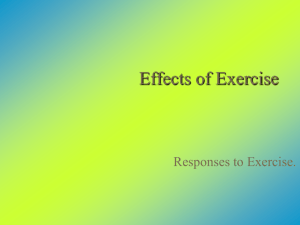Mrs PL. 61yo female, asthma, SOBOE
advertisement
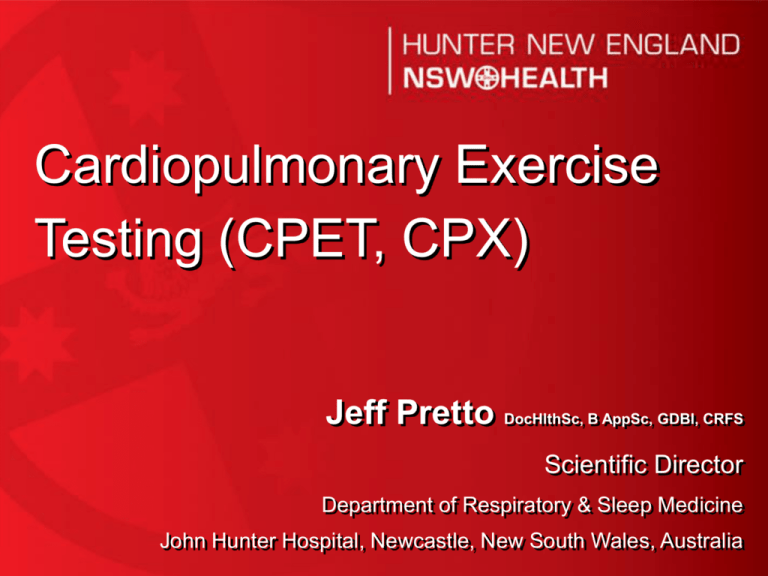
Cardiopulmonary Exercise Testing (CPET, CPX) Jeff Pretto DocHlthSc, B AppSc, GDBI, CRFS Scientific Director Department of Respiratory & Sleep Medicine John Hunter Hospital, Newcastle, New South Wales, Australia 0 CPET – Equipment • Ergometer Cycle (electronically braked) Treadmill (speed & grade adjustment) • Metabolic analysis system • Pulse oximeter, ECG recorder • Emergency Trolley (incl. defibrillator, emergency drugs) • Total ~$ 80-100k 1 Cycle or Treadmill? * Zeballos and Weismann. Clinical exercise testing. WB Saunders, Karger, USA, 2002. ISBN-10: 3805572980 2 CPET - Exercise Format • Incremental workload Bruce / Ellestad / Naughton / Balke / Astrand protocols (specifically for treadmill) Fixed increment per minute (Winc of 5W – 30W) Aim to achieve ~10 minute test duration Winc can be determined from baseline pulmonary function* * Pretto et al. Using baseline respiratory function data to optimise cycle exercise test duration. Respirology 2001, 6: 287-91 3 Metabolic Equivalents (NSW Department of Health. 2006. NSW Chronic Care Program) 5–10 15–35 40-60 60–80 80–100 100–120 120-150 150–170 Approx. Workload (Watts) 170–190 200+ 4 CPET Report 5 CPET Report End-of-test symptoms Reason for test Maximum values (compared with predicted) Efficiency of ventilation HR / SpO2 responses Interpretative comment 6 Normal response to exercise • Limited by cardiac, rather than respiratory factors - Approach predicted HRmax - Some ventilatory reserve (~30%) • Adequate Wmax, VO2peak, oxygenation • Highly trained athletes: May have evidence of respiratory limitation May develop hypoxaemia Elevated Wmax, VO2peak 7 VE – VO2 Graph Indicates efficiency of O2 extraction 120 VE (L/min) Normal range 90 60 Normal 30 Wasted ventilation 1.0 2.0 3.0 VO2 (L/min) 8 COPD • • • Exercise intolerance multi-factorial: - Reduced ventilatory capacity - Peripheral muscle dysfunction - O2 transport abnormalities - Exertional symptoms - Development of dynamic hyperinflation Primary findings: - Increased ventilatory requirements (wasted ventilation) - Reduced Wmax - Little ventilatory reserve Other findings: - Arterial oxygen desaturation (larger SpO2 observed during walking than cycling)* *Turner et al: Physiologic responses to incremental and self-paced exercise in COPD. Chest, 2004, 126: 766-73 9 COPD: Typical end test values Measured % Pred Max. HRmax 128 bpm 65% VEmax 45 L/min 115% (of 35×FEV1) VO2max 1.41 L/min 60% Wmax 70W 54% Borg scores: Leg fatigue:4, Dyspnoea: 8.5 “Evidence of ventilatory limitation, with some cardiac reserve. Maximal workload achieved was significantly reduced below the predicted value.” 10 Interstitial Lung Disease • Increased ventilatory response (wasted ventilation) • Shallow rapid breathing (low VT, high RR) • Arterial desaturation Correlates with disease severity better than other PFTs Provides most useful prognostic indicator Predicts survival 11 Typical CPX response in ILD* • Reduced maximal workload (Wmax) • Increased ventilatory response with reduced ventilatory reserve (VEmax/MVV) • Increased breathing frequency • Fall in PaO2, SpO2 • Typically, elevated HR-VO2 relationship * Lama et al,Clin Chest Med, 2004, 25:435-53 12 Typical CPX response in ILD 13 Cardiac Response Cardiac Output (CO) = Stroke volume (SV) × HR if SV cannot , CO can only increase by rises in HR HR response is steeper Normal Heart disease 200 HR (beats/min) 150 SV (ml) 150 100 100 50 50 1.0 2.0 3.0 VO2 (L/min) 14 Heart rate response Athlete Deconditioned (unfit) Cardiac disease HR (beats/min) Normal range 200 150 100 50 1.0 2.0 3.0 VO2 (L/min) 15 CPET Response – 50yo competitive cyclist 16 Oxygen Pulse = VO2 (ml/min) / HR (bpm) = mls of O2 taken up per heart beat = non-invasive estimate of stroke volume O2 pulse (ml/beat) 20 Normal Pulm. hypertension 10 IHD 1.0 2.0 3.0 VO2 (L/min) 17 Mrs PL. 61yo female, asthma, SOBOE 18 Mrs PL. 61yo female, asthma, SOBOE 19 Mrs PL. 61yo female, asthma, SOBOE 20 Mrs PL. 61yo female, asthma, SOBOE 21 Mrs PL. 61yo female, asthma, SOBOE 22 Mrs PL. 61yo female, asthma, SOBOE 23 18yo male, Fontan circulation 24 18yo male, Fontan circulation 25 52yo female, known airways disease, disproportionate SOBOE 26 47yo male, difficult asthma, SOBOE 27 Summary • Exercise testing rarely provides a definitive diagnosis • Specific patterns of response are characteristic of different disease states • CPET is particularly useful in the following applications: Determination and quantification of functional impairment or capacity Functional evaluation of unexplained exertional dyspnoea and/or exercise intolerance Differentiation between cardiac, pulmonary or other causes of dyspnoea and/or exercise limitation Functional and prognostic evaluation in known pulmonary disease Pre-operative evaluation of cardiopulmonary fitness and suitability for surgery 28 Further reading • ERS Task Force: Recommendations on the use of exercise testing in clinical practice. Eur Respir J 2007, 29: 185-209 - Evidence-based recommendations on the clinical use of CPET. • Wasserman et al. Principles of Exercise Testing and Interpretation. 4th ed.Lippincott Williams & Wilkins. Philadelphia, 2005 ISBN-10: 0781748763 - Excellent reference for physiology, testing techniques, interpretation and multiple case studies. • Hancox & Whyte. McGraw Hill’s Pocket Guide to Lung Function Tests. McGraw Hill, Sydney 2001. ISBN-10: 0074715968 - Concise pocketbook guide to lung function tests with good summary of exercise testing 29 30 Patterns of response in different diseases* * ERS Taskforce, ERJ, 1997, 10: 2662 - 99 31 The Anaerobic Threshold • At low workloads, energy source is predominantly aerobic • As exercise intensity increases, ventilation increases (linearly) to meet oxygen demand • Eventually, a point is reached where anaerobic metabolism is required to perform extra work • By-product is lactic acid acidaemia offload CO2 to buffer ventilation relative to oxygen demand • Results in inflection in the VE/VO2 relationship 32 33
